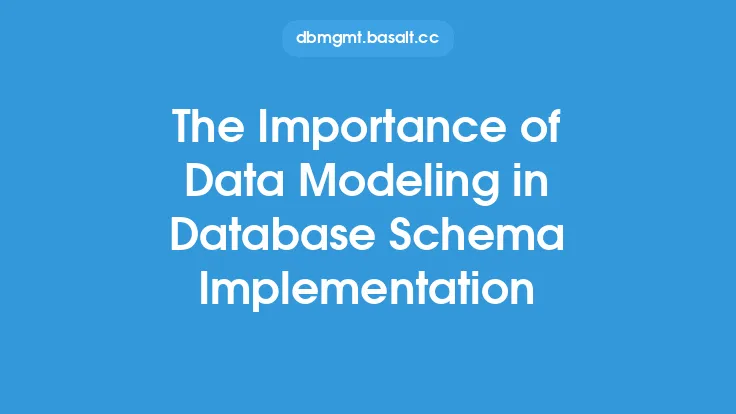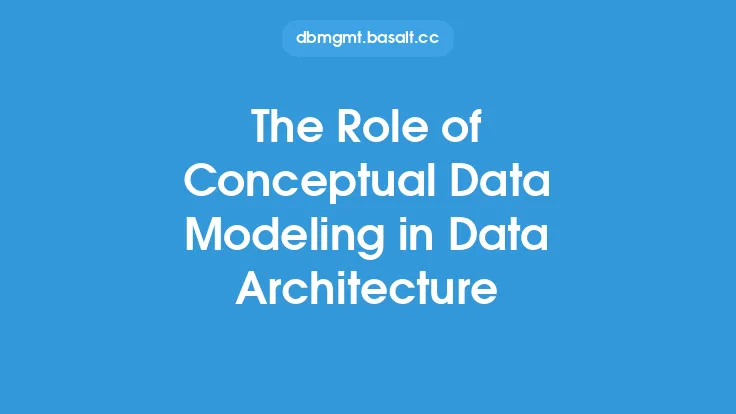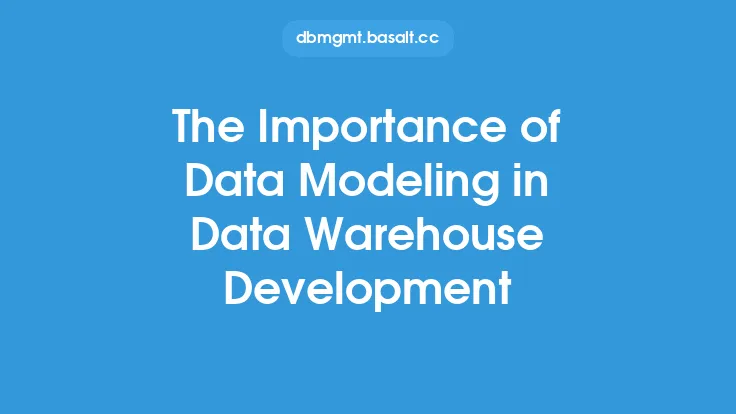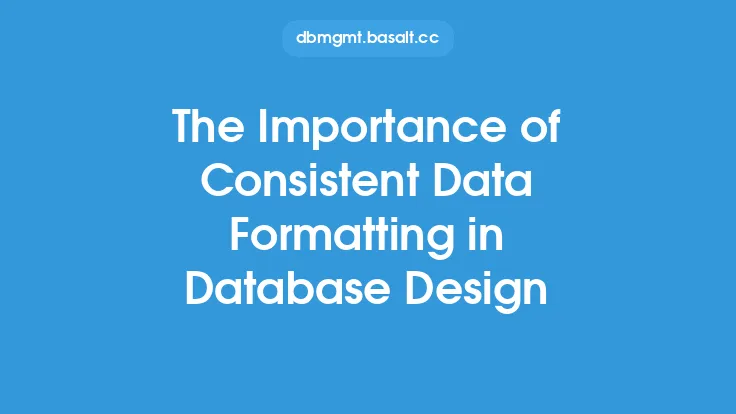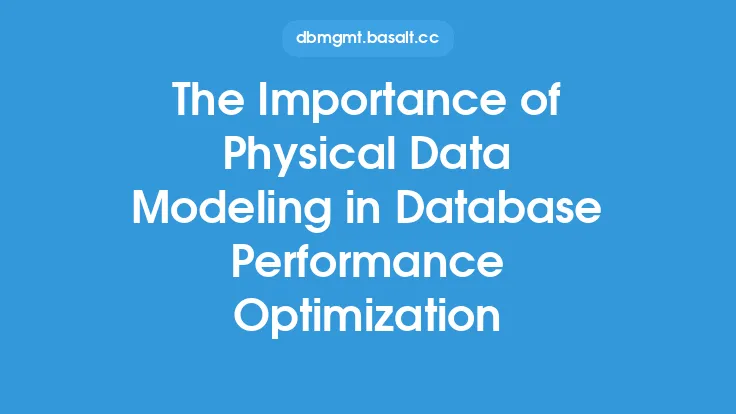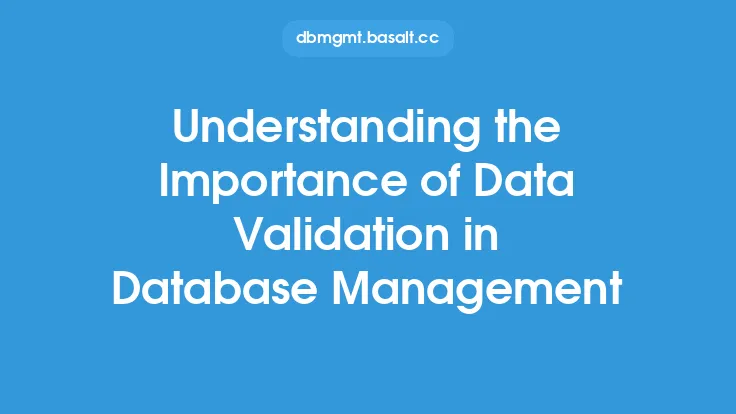When designing a database, it's essential to have a clear understanding of the data and its relationships. This is where conceptual data modeling comes into play. Conceptual data modeling is a crucial step in the database design process, as it helps to identify the key entities, attributes, and relationships that will be used to store and manage data. In this article, we'll explore the importance of conceptual data modeling in database design and how it can help to create a robust, scalable, and maintainable database.
Introduction to Conceptual Data Modeling
Conceptual data modeling is a high-level approach to data modeling that focuses on the overall structure and organization of the data. It's concerned with identifying the key concepts, entities, and relationships that will be used to store and manage data. This approach is often used in the early stages of database design, as it helps to establish a clear understanding of the data and its requirements. Conceptual data modeling is typically performed using a variety of techniques, including entity-relationship modeling, object-role modeling, and dimensional modeling.
Benefits of Conceptual Data Modeling
There are several benefits to using conceptual data modeling in database design. One of the primary benefits is that it helps to ensure data consistency and integrity. By identifying the key entities, attributes, and relationships, conceptual data modeling helps to establish a clear understanding of the data and its requirements. This, in turn, helps to prevent data inconsistencies and errors, which can be costly and time-consuming to fix. Another benefit of conceptual data modeling is that it helps to improve data sharing and reuse. By establishing a clear understanding of the data and its relationships, conceptual data modeling makes it easier to share and reuse data across different applications and systems.
Key Concepts in Conceptual Data Modeling
There are several key concepts in conceptual data modeling that are essential to understand. One of the most important concepts is the entity, which represents a thing or concept that has significance to the organization. Entities can be objects, events, or concepts, and they are typically represented using a unique identifier. Another key concept is the attribute, which represents a characteristic or property of an entity. Attributes can be used to describe the entity, such as its name, address, or date of birth. Relationships are also a key concept in conceptual data modeling, as they represent the connections between entities. Relationships can be used to establish hierarchies, networks, or other types of connections between entities.
Techniques for Conceptual Data Modeling
There are several techniques that can be used for conceptual data modeling, including entity-relationship modeling, object-role modeling, and dimensional modeling. Entity-relationship modeling is a popular technique that uses entities, attributes, and relationships to model the data. This technique is often used in relational databases, as it helps to establish a clear understanding of the data and its relationships. Object-role modeling is another technique that uses objects and roles to model the data. This technique is often used in object-oriented databases, as it helps to establish a clear understanding of the data and its relationships. Dimensional modeling is a technique that uses facts and dimensions to model the data. This technique is often used in data warehousing and business intelligence, as it helps to establish a clear understanding of the data and its relationships.
Best Practices for Conceptual Data Modeling
There are several best practices that can be used for conceptual data modeling. One of the most important best practices is to involve stakeholders in the modeling process. Stakeholders can provide valuable insights and feedback, which can help to ensure that the model is accurate and complete. Another best practice is to use a consistent notation and terminology. This helps to ensure that the model is clear and easy to understand, which can reduce errors and misunderstandings. It's also essential to validate the model against the business requirements and rules. This helps to ensure that the model is accurate and complete, and that it meets the needs of the organization.
Common Challenges in Conceptual Data Modeling
There are several common challenges that can arise in conceptual data modeling. One of the most significant challenges is ensuring that the model is accurate and complete. This requires a deep understanding of the data and its relationships, as well as the business requirements and rules. Another challenge is communicating the model to stakeholders, who may not have a technical background. This requires the use of clear and concise notation and terminology, as well as effective communication and presentation skills. It's also essential to manage the complexity of the model, which can become unwieldy if not managed properly. This requires the use of techniques such as abstraction and decomposition, which can help to simplify the model and make it easier to understand.
Tools and Technologies for Conceptual Data Modeling
There are several tools and technologies that can be used for conceptual data modeling. One of the most popular tools is entity-relationship modeling software, such as ERwin or PowerDesigner. These tools provide a graphical interface for creating and editing entity-relationship models, and they can help to simplify the modeling process. Another tool is object-role modeling software, such as ORM Designer or NORMA. These tools provide a graphical interface for creating and editing object-role models, and they can help to simplify the modeling process. There are also several open-source tools and technologies available, such as MySQL Workbench or DbDesigner 4. These tools provide a free and open-source alternative to commercial software, and they can be used for a variety of data modeling tasks.
Conclusion
In conclusion, conceptual data modeling is a crucial step in the database design process. It helps to identify the key entities, attributes, and relationships that will be used to store and manage data, and it provides a clear understanding of the data and its requirements. By using conceptual data modeling, organizations can ensure data consistency and integrity, improve data sharing and reuse, and create a robust, scalable, and maintainable database. Whether you're using entity-relationship modeling, object-role modeling, or dimensional modeling, conceptual data modeling is an essential technique that can help to ensure the success of your database design project. By following best practices, using the right tools and technologies, and managing complexity, you can create a conceptual data model that meets the needs of your organization and provides a solid foundation for your database design.
